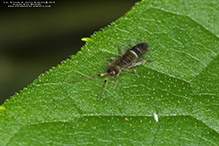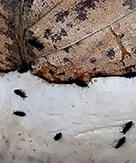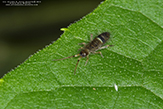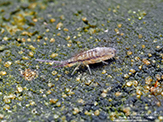Minnesota Springtails
Collembola is the class of hexapods called springtails. Traditionally, springtails were placed in the order Collembola under the class Insecta. Later, the order was placed in the class Entognatha along with orders Diplura (two-pronged bristletails) and Protura (coneheads). It was later determined that the three orders were derived from more than one evolutionary ancestor (polyphyletic), and the class Entognatha was therefore invalid. Most authors now place springtails in the class Collembola. One notable exception is iNaturalist.org, which treats Collembola as a subclass of Class Entognatha.
Springtails are characterized by the following:
- oval or elongated body;
- minute, no more than ¼″ (6 mm) long;
- abdomen with 6 or fewer segments;
- a ventral tube (collophore) projecting from the first abdominal segment;
- no wings;
- short antennae with 4 to 6 segments;
- hidden, internal mouthparts; and
- most, but not all, have a forked, tail-like appendage on the abdomen that allows them to jump.
Springtails are cosmopolitan, occurring on every continent including Antarctica. There are more than 8,200 described species in more than 670 genera in 31 families in 4 orders of springtails worldwide. There are at least 19 species in 13 genera in Minnesota.

Recent Additions

Hypogastrura is a genus of springtails. They are sometimes called snow fleas, but this common name is properly applied to just one species, Hypogastrura nivicola. There are at least 159 Hypogastrura species worldwide, at least 89 species in North America, and at least 1 species in Minnesota. They are found in moist areas rich in organic matter. They often appear in in very large numbers.
Hypogastrura springtail has a plump, elongated oval body. It is bluish-black but appears black when viewed against a light background. The legs and antennae are short. Identifying a springtail to the genus Hypogastrura is relatively simple, but identifying one to the species is extremely difficult. It requires microscopic examination of the hairs on the last leg segment.

Belted springtail (Orchesella cincta) is a large slender springtail. It occurs in western Europe, southern Canada, and northern United States. It is one of the most common and one of the largest springtails in the United Kingdom. Based on the number of records, it is uncommon in Minnesota. However, it is probably underreported due to its small size and habitat preferences. It is found in soil, leaf litter, rotting wood, and moss, under stones, and on tree trunks.
Adults are slender, about ⅛″ long, and reddish-brown, brown, or blackish-brown. They are covered with long hairs. The abdomen has a white band followed by a very dark band, making the abdomen appear “belted”. This is the source of the common name of the species.
Other Recent Additions

This list includes only springtails that have been recorded in Minnesota, but not all of the springtails found in Minnesota.
| Profile | Photo | Video | |||
|---|---|---|---|---|---|
|
|
|||||
cosmopolitan springtail (Entomobrya nivalis) |
|||||
cotton springtail (Entomobrya unostrigata) |
|||||
damp grain springtail (Willowsia buski) |
|||||
elongate-bodied springtail (Cyphoderus similis) |
|||||
garden springtail (Bourletiella hortensis) |
|||||
globular springtail (Bourletiella arvalis) |
|||||
globular springtail (Deuterosminthurus bicinctus) |
|||||
globular springtail (Pseudosinella rolfsi) |
|||||
globular springtail (Sminthurinus henshawi) |
|||||
globular springtail (Sminthurinus elegans) |
|||||
hypogastrurid springtails (Family Hypogastruridae) |
|||||
slender springtail (Lepidocyrtus paradoxus) |
|||||
slender springtail (Willowsia nigromaculata) |
|||||
smooth springtail (Isotoma viridis) |
|||||
snow flea (Hypogastrura nivicola) |
|||||
water springtail (Podura aquatica) |
Bourletiella arvalis (globular springtail)
Bourletiella hortensis (garden springtail)
Cyphoderus similis (elongate-bodied springtail)
Deuterosminthurus bicinctus (globular springtail)
Entomobrya clitellaria (slender springtail)
Entomobrya nivalis (cosmopolitan springtail)
Entomobrya unostrigata (cotton springtail)
Homidia socia (slender springtail)
Hypogastrura nivicola (snow flea)
Hypogastrura spp. (springtails)
Hypogastruridae (hypogastrurid springtails)
Isotoma viridis (smooth springtail)
Lepidocyrtus paradoxus (slender springtail)
Orchesella cincta (belted springtail)
Podura aquatica (water springtail)
Pseudosinella rolfsi (globular springtail)
Sminthurinus elegans (globular springtail)
Sminthurinus henshawi (globular springtail)
Willowsia buski (damp grain springtail)
Willowsia nigromaculata (slender springtail)
No Species Page Yet?
If you do not see a linked page for a species in the list at left you can still upload a photo or video or report a sighting for that species. Click on one of the buttons below and type in the common name and/or scientific name of the species in your photo, video, or sighting. A new page will be created for that species featuring your contribution.
These buttons not working for you?
Simply email us at info@MinnesotaSeasons.com.



